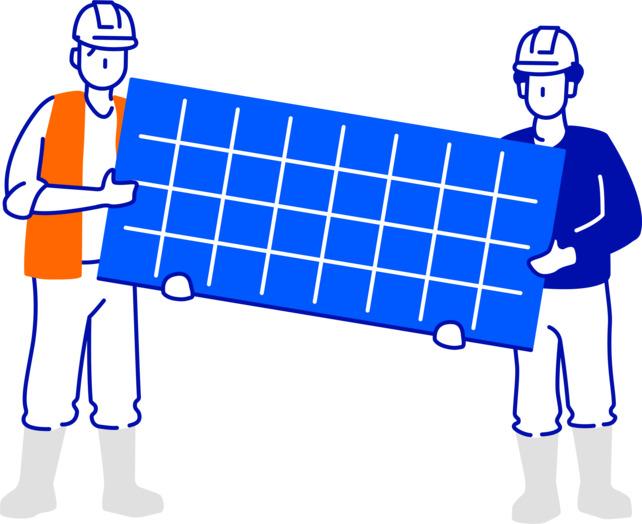Since 2021, we as Rabobank in Limburg have been involved in energy hubs. Especially in the early years, this was a process of trial and error. We have since learned valuable lessons, and we recently set up a project to make a good assessment of which business parks are suitable for starting an energy hub. It is becoming increasingly clear that successful project implementation depends on the right choices and proper preparation. In this blog, I am happy to share our findings and give a sneak peek into our business parks tooling and what it can do for you.

The business park tool
In 2022, Volantis, co-initiated by Rabobank in Limburg, conducted a study of business parks in Venlo. This study resulted in a number of criteria that were ranked based on a 10 different factors. These findings served as the basis for our own research within Rabobank, where we added a large number of variables mainly based on desktop. The main main criteria are:
- Net congestion
- Organization rate of the business park
- Environmental aspects .
- Statements of intent regarding sustainability at the business park
Subdividing these aspects into a number of variables and assigning a weighting to them produces a ranking. It is essential that the answer to the first two criteria be positive for final consideration. In other words, grid congestion must exist and be perceived to exist. In addition, the level of organization of the business park is indispensable for an energy hub project to have a reasonable chance of success. In recent years, this combination of urgency regarding grid congestion and a well-organized business park has proven to be a winning formula. The best part is if there is also a catalyst from within the business park.
In the end, about half of all business parks in Limburg - whether clustered with adjacent business parks or not - are involved in the follow-up steps.
Deepening the tooling
Next, the tooling delves into two main topics; the environmental aspects and the declaration of intent for sustainability. The environmental aspects include several variables. These mainly involve the presence of certain businesses or conditions nearby or even on the business park. These include solar or wind farms, horticultural companies, transportation companies, data centers and, for example, a residual heat grid. The fourth and final aspect examines whether the business park is already making a collective commitment to sustainability by making mutual agreements in a letter of intent or a so-called Green Deal.
These two criteria mainly show whether there are interconnection opportunities and also provide an important insight: an energy hub is certainly not just about electricity. In addition, the last aspect (making the business park more sustainable) provides insight into the willingness of the business park to work together on sustainability. Good cooperation is essential for broad sustainability, but also certainly if you want to work with multiple companies toward an energy hub.
Based on desk research, we have determined a good starting point for which business parks in Limburg score high and which need some more preparatory work. However, the research does not give a picture of the size of the site and the consumption of heat, gas and electricity. A short follow-up study will have to show that.
This tooling, along with the consumption survey, provides enough leads that a project team can work with to obtain the necessary permissions. For example, we can use energy consumption mapping.
Research Outcomes
Of the nearly 300 business parks, half were eventually included in the ranking. The other half were dropped on the first two criteria: grid congestion and especially the degree of organization of the business parks.
The results are interesting to further deepen with an exploratory follow-up study. The top 3 (outside Chemelot Sittard-Geleen) consists of:
- cluster Greenport (Venlo)
- cluster Roerstreek and Oostangent (Roermond)
- Beatrixhaven (Maastricht)
If we look further into the larger towns, the following business parks score the highest in their municipalities:
- Smakterheide (Venray)
- cluster Kampershoek (Weert)
- Bergerweg (Sittard-Geleen)
- In the Parkstad region, De Horsel (Nuth), cluster De Koumen (Heerlen) and Dentgenbach (Kerkrade) score high
Reacties (2)
Wednesday 29 May 2024 - 20:55
In reply to Klopt, Richard! by Ron Bissels
Helemaal goed, Ron
Voor je beeld: Beatrixhaven is de nummer 1 bedrijventerrein van Maastricht uit ons onderzoek! Dus meer dan kansrijk. Het begint echter ook om achter de meter te kijken naar de data en te kijken of er niet ook -buiten de energy hub- ook mogelijkheden zijn voor het individuele bedrijf. Daar is vaak al de eerste winst te behalen! Mooi om te vernemen, Ron, en als ik nog kan toevoegen. hoor ik het graag!
Tuesday 23 April 2024 - 18:47
Klopt, Richard!
Op Beatrixhaven in Maastricht werken we vanuit de gemeente inmiddels hard aan uitbreiding van de samenwerking. Steeds meer bedrijven doen mee met de verkenning, delen hun energiedata, die we analyseren en toevoegen aan de digital twin. Met Enexis' Parkmanagement werken we samen en krijgen een steeds completer beeld van de nettopologie. Op die manier zien we - naast natúúrlijk datgene wat 'n bedrijf binnen de eigen poort kan doen zoals energiebesparing en optimalisatie beschikbare vermogen - steeds beter hoe bedrijven kunnen samenwerken in energy hubs. Een intensieve klus, maar men krijgt er 'energie' van.